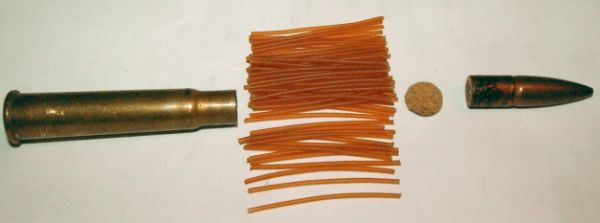-
Legacy Member

Ammo Question
Picked this up at a recent gun show. Head stamp is R^L 1938 B lV
Would be grateful for help with an ID.
Information
 |
Warning: This is a relatively older thread
This discussion is older than 360 days. Some information contained in it may no longer be current. |
|
-
-
03-09-2009 09:15 PM
# ADS
Friends and Sponsors

-
Legacy Member

Preserve Historic Artifacts for Future Generations: Collect Firearms
-
-
-
Legacy Member

Now you can go balloon busting
-
-
Legacy Member

RL was the logo for Royal Ordnance Factory, Woolowich.
It was given the title in the late 1600s. It was huge, stretching for miles down the south side of the Thames, east of London. It closed as a Factory in the mid 60s.
There was never much love lost between the staff of Woolwich and Enfield. Woolwich was the premier Ordnance Factory, but it had little influence over Enfield, with its unique existence as THE Royal Small Arms Factory.
-
-
Legacy Member

yes, they are incendiaries, the parallel portion was originally intended to cut a good hole in balloon fabric. If you shoot them they leave a smoke trial.
This design was superseded by improved incendiaries in WW2.
-
-
Legacy Member

Another pic
A couple of the necks are split and this bullet virtually fell out. I expected the powder to pour out but it appears to held i place with some sort of "wad" or packing. Is this specific to this round or is it common with others?
Thanks for the link and info!!
Also is there any reason not to shoot some of these (at targets other than balloons)? Any special cleaning concerns?
Last edited by carbineer; 03-10-2009 at 08:32 PM.
-
-
Head Moderator
(Founding Partner)


Site Founder

The powder didn't fall out because there isn't any "powder" in the case.
Below the carboard wad you'll find many fine strands of cordite packed in the case. I used to pull them apart in my younger days and use the cordite as fuses when destroying my plastic models.
-
-
FREE MEMBER
NO Posting or PM's Allowed

The "powder" is cordite, which is an extruded double base powder cut into long (around 1 1/4") strands or "cords", hence the name. It is loaded into the cartridge case and a cardboard wad put on top before the case is necked down. What you see is the wad.
Cordite was the preferred propellant for British military ammunition from almost the first use of smokeless powder to the end of the .303 era. It was satisfactory in many ways, and was very stable, but was also highly erosive due to its nitroglycerin component. For pistol use, it was chopped into smaller pieces.
military ammunition from almost the first use of smokeless powder to the end of the .303 era. It was satisfactory in many ways, and was very stable, but was also highly erosive due to its nitroglycerin component. For pistol use, it was chopped into smaller pieces.
Jim
-
FREE MEMBER
NO Posting or PM's Allowed

Yep Cordite got some on the reloading bench just to start some talk over.
-
Advisory Panel


-















 PM
PM













